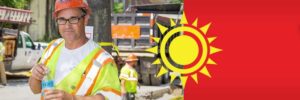OSHA’s Heat Illness Prevention campaign, launched in 2011, educates employers and workers on the dangers of working in the heat. Through training sessions, outreach events, informational sessions, publications, social media messaging and media appearances, millions of workers and employers have learned how to protect workers from heat. Our safety message comes down to three key words: Water. Rest. Shade.
Dangers of Working in the Heat
Every year, dozens of workers die and thousands more become ill while working in extreme heat or humid conditions. There are a range of heat illnesses and they can affect anyone, regardless of age or physical condition.
Employer Responsibility to Protect Workers
Under OSHA law, employers are responsible for providing workplaces free of known safety hazards. This includes protecting workers from extreme heat. An employer with workers exposed to high temperatures should establish a complete heat illness prevention program.
- Provide workers with water, rest and shade.
- Allow new or returning workers to gradually increase workloads and take more frequent breaks as they acclimatize, or build a tolerance for working in the heat.
- Plan for emergencies and train workers on prevention.
- Monitor workers for signs of illness.
Resources
OSHA’s Occupational Exposure to Heat page explains what employers can do to keep workers safe and what workers need to know – including factors for heat illness, adapting to working in indoor and outdoor heat, protecting workers, recognizing symptoms, and first aid training. The page also includes resources for specific industries and OSHA workplace standards. Also look for heat illness educational and training materials on our Publications page.
Information provided by the Occupational Safety and Health Administration
